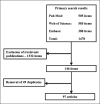Current interventional management of male stress urinary incontinence following urological procedures
- PMID: 26568879
- PMCID: PMC4643709
- DOI: 10.5173/ceju.2015.616
Current interventional management of male stress urinary incontinence following urological procedures
Abstract
Introduction: Despite improvements in surgical techniques and implementation of minimally invasive procedures, male stress urinary incontinence affects a substantial number of patients after prostatic surgery. In response to increasing demand of optimal treatment modality, new alternatives to artificial urinary sphincter have recently been introduced. This review summarises the therapeutic surgical options with their outcomes in management of postprostatectomy stress incontinence.
Material and methods: We performed a literature review by searching the PubMed, Web of Science and Embase databases for articles published from January 2000 until April 2015 based on clinical relevance.
Results: Artificial urinary sphincter is currently considered the "gold standard" treatment of male stress urinary incontinence. Although the new devices in this group have recently been investigated, the AMS 800 remains the only widely used implant. Male slings and adjustable continence devices, achieve the social continence rates up to 60%. Periurethral injections of bulking agents, have limited efficacy of male stress incontinence. Argus sling and ProACT are both associated with substantial explantation rates. Stem cell therapy is a promising option but still requires additional testing.
Conclusions: The development of new alternatives to artificial urinary sphincter is constantly progressing. Although recently introduced minimally invasive treatment options have not yet surpassed the outcomes of the artificial urinary sphincter they should continue to be evaluated and compared against the gold standard.
Keywords: artificial urinary sphincter; bulking agents; pro-ACT; stem cells.
References
-
- Abrams P, Cardozo L, Fall M, et al. The standardisation of terminology of lower urinary tract function: report from the Standardisation Sub-committee of the International Continence Society. Neurourol Urodyn. 2002;21:167–178. - PubMed
-
- Bauer RM, Bastian PJ, Gozzi C, Stief CG. Postprostatectomy incontinence: all about diagnosis and management. Eur Urol. 2009;55:322–333. - PubMed
-
- Herschorn S, Bruschini H, Comiter C, et al. Surgical treatment of stress incontinence in men. Neurourol Urodyn. 2010;29:179–190. - PubMed
-
- Rassweiler J, Teber D, Kuntz R, Hofmann R. Complications of transurethral resection of the prostate (TURP)-incidence, management, and prevention. Eur Urol. 2006;50:969–979. - PubMed
Publication types
LinkOut - more resources
Full Text Sources
Other Literature Sources
Miscellaneous

